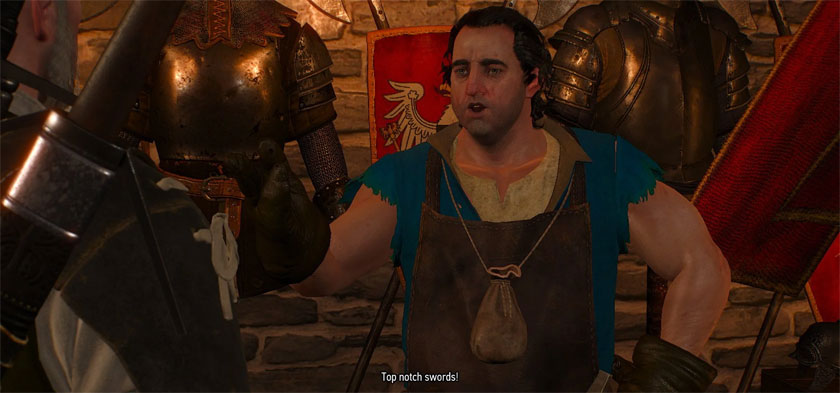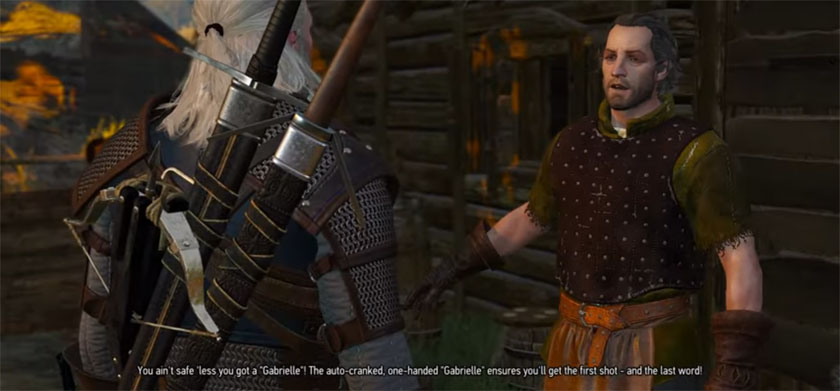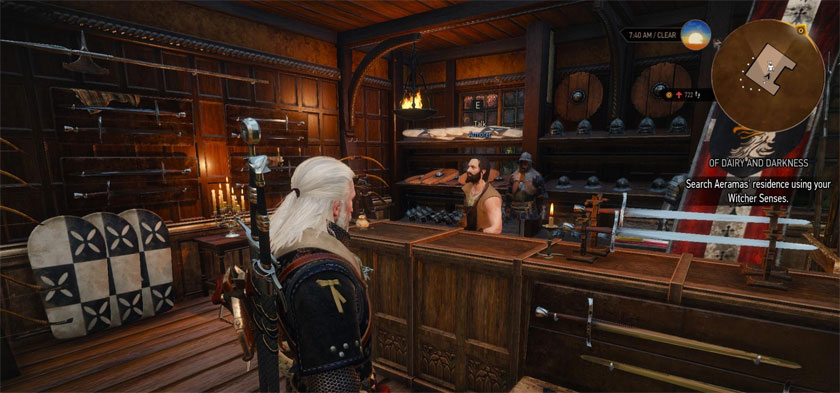Word Smiths

The sheer volume of unique dialogue and voiced lines in The Witcher 3 is amazing. It may be old news to many of you by now, but I’ve only been making my way through the game for the past month. I’ve played a number of huge, open-world games over the past decade, but it’s pretty obvious how much effort went into making CD Projekt’s fantasy opus feel like a lived-in realm.
I’ve come to recognize different blacksmiths in different towns based on their greeting of me. “Top notch swords!” comments the armorer in Novigrad, admiring the work of the two blades strapped across Geralt’s back. He’s a bit huskier compared to the others. The smith in Oxenfurt is always pleased to see the White Wolf stroll into his abode, preparing to commission a far more interesting work order than the rote, copy-paste desires of the invading Nilfgaardian army. The armorer in Midcopse smugly tries to sell me a crossbow of supposedly high-quality, despite dealing strictly in defensive garments as opposed to hostile armaments.
That I can recall my interactions with each of these professionals of The Witcher 3 is indicative of the attention to detail placed into this world. Rather than giving each armorer or smithy a generic greeting with the exact same voice, they are each separate character models with different voice actors speaking different lines. Such a small detail contributes greatly to the depth that inhabits every corner of The Witcher 3.
I wish they’d just shut up and take me right into the shop screen already.
Towards the end of my slap-dash piece-of-trash video on Mega Man X, I idiotically proclaimed that games aren’t supposed to be immersive, but engaging. I don’t know what possessed me to make this claim, and I can only imagine that sheer laziness kept me from replacing that line with something far better.
The truth is that I’ve struggled with this concept of immersion for a long time, as the steps taken to make a game more “immersive” consistently seem to run contrary to why I play video games. Or, in the case of The Witcher 3’s many blacksmiths, grow increasingly tiresome as I just need someone to offload a bunch of excess bandit equipment onto. More often than not the exchange of gear for coin has been more of a haggling. The crowns placed into my pocket are immediately handed back for the sake of crafting new armor, sharpening my blades, or dismantling old and worn equipment in order to preserve the runes embedded within.

It is a task I wish to complete as swiftly as possible, and therefore I do not wish to hear “Top notch swords!” for the fifteenth time since hacking and slashing through the side quests of Novigrad. Worse still, as I cannot swap my equipped gear from the shop menu, I must instead conclude my conversation with the shop keep, then open my inventory to swap the necessary gear, and finally proceed through the exchange again in order to dismantle or sell off the obsolete armor and weapons.
One of the greatest features of Chrono Trigger, a game released on the Super Nintendo more than twenty years ago now, was the ability to change equipment and gear from within the shop interface. There was no cycle of purchasing equipment, canceling out of the shop menu only to access your personal inventory, swap gear around, and then open the shop menu once more in order to sell the old gear you no longer desired. You remained in the shop interface until the exchange of goods and services was complete. It felt like a revelation at the time, and… no one seemed to take notice of the absolute convenience this presented. Even other JRPGs failed to imitate this efficiency despite the abandonment of fast-loading cartridge memory in favor of slower disc speeds across the industry.
I happen to simultaneously be dipping into Xenoblade Chronicles Definitive Edition as I play The Witcher 3, and despite it, too, failing to allow immediate gear swapping from within its shop menu, I at least get to jump right into the shop in far less time than The Witcher 3. Sure, I get a generic “Hi there!” from almost every NPC, so far zoomed-out and with such a generic design they may as well have no face at all. The pay-off is that I get to waste less time hearing the same dialogue repeated over-and-over whenever I need to reduce my party’s encumbrance.
It is this sort of preference that led me to make such a silly claim roughly eight years ago. Games can be immersive, certainly. However, I often find those efforts to immerse players to instead impede on a game’s usability. The first time I visit a blacksmith, a unique line of dialogue is interesting and immersive. Every subsequent visit, however, becomes tedious. The immersion is broken as the shopkeep fails to recognize Geralt, spitting out the same line over and over. Even worse that they’ll spit the line out again immediately after conducting the first round of business, interrupted only by the very-not-immersive need to jump from the shop screen to the inventory screen and back.
From my perspective, there are only two solutions to this problem. The first is to eliminate the attempt at immersion and just drop the player into the inventory screen. Let their unique line of dialogue be overheard as they approach rather than booting up a dialogue menu and camera angles. The second solution would be to give every blacksmith several lines of spoken dialogue, commenting on Geralt’s new appearance, his patronage, or perhaps even a disgruntled complaint of the pile of cheap bandit weapons piling up from the beast hunter’s prior visits. This latter option would certainly be more immersive, but it would also be an even greater demand on a team that was clearly stretched thin on a project of this scale.

Of course, I suspect there is an additional reason for this dialogue menu to exist. For a time I had wondered why they gave me the option to either see a shopkeeper’s wares or ask them to craft something. Both options go to the same menu, after all. They’re just one tab away from one another, a simple bumper-click to switch from one page to the other. Why bother with this dialogue at all?
Because players may wish to play Gwent! That is the best reason I can imagine for there being an entire dialogue menu for when you wish to go shopping. You may not wish to shop at all! You may instead desire to spend time on a card game instead.
Yet another problem that feels as if it had been solved approximately twenty years ago. In Final Fantasy VIII and Final Fantasy IX, if you wished to play a card game with someone, you simply pressed a different button to challenge them than to converse with them. A similar solution could have been provided here, or to simply allow for a button prompt within the shopkeep menu to challenge to a round of Gwent.
It may seem silly to raise this much of a ruckus over something as simple as suffering through a quick line of dialogue every time you visit a shop keeper. You can, after all, skip such chatter. Only one line at a time, of course, meaning not much time is saved in the end, but you can still do it!
I think it is in little things such as this that you can see where a player’s or developer’s preference lies, however. I do not, nor have I ever, played games in order to get sucked into a believable world. I certainly enjoy imaginative ones, and there’s definitely appreciation for the technical accomplishments of The Witcher 3. However, I’m more likely to love and return to a game whose mechanics are enjoyable, regardless of how believable they are. If, however, you care less about a game’s combat mechanics and more about how the houses of Velen look truly impoverished compared to the noble mansions of Novigrad, then you’ll likely never stop to wonder if there’s a more efficient way to drop a player into a shop menu.
Perhaps I’ll have better examples to use in the future. I am still playing through The Witcher 3, and I have a feeling I’ll have more thoughts regarding the game once complete. For now, however, this is just one example where I’d rather they stuck to the Chrono Trigger style of armor and weapon merchants than the immersive, unique, time-consuming – for player and developer alike – method of The Witcher 3.


